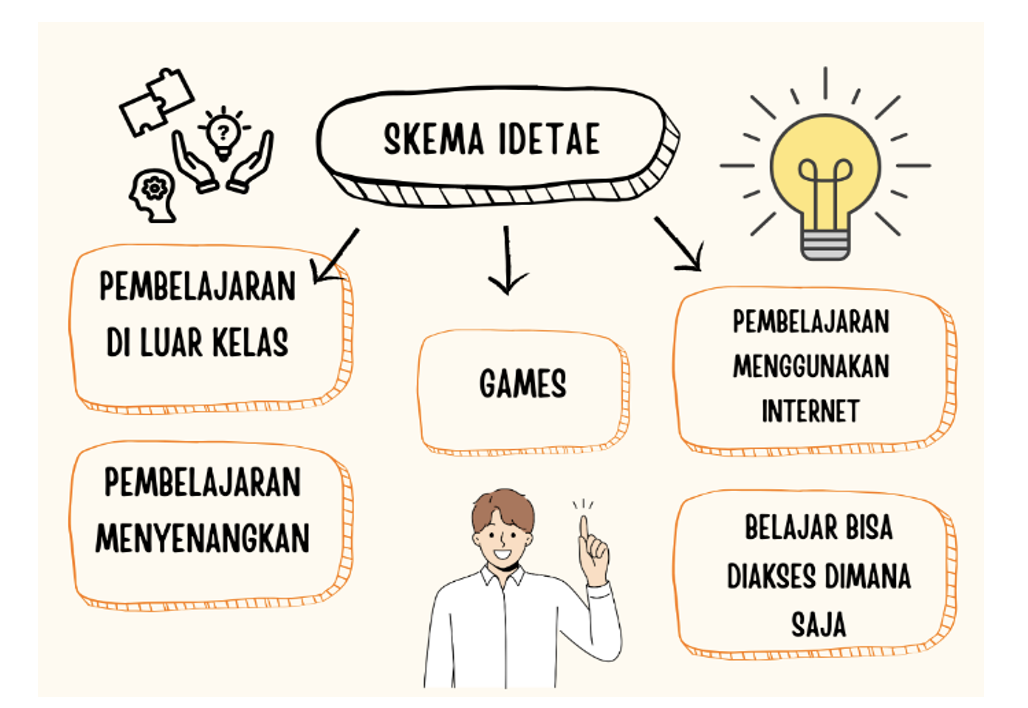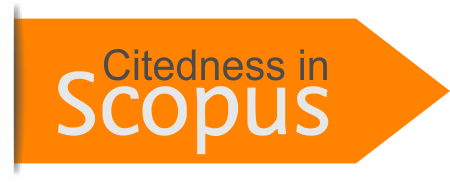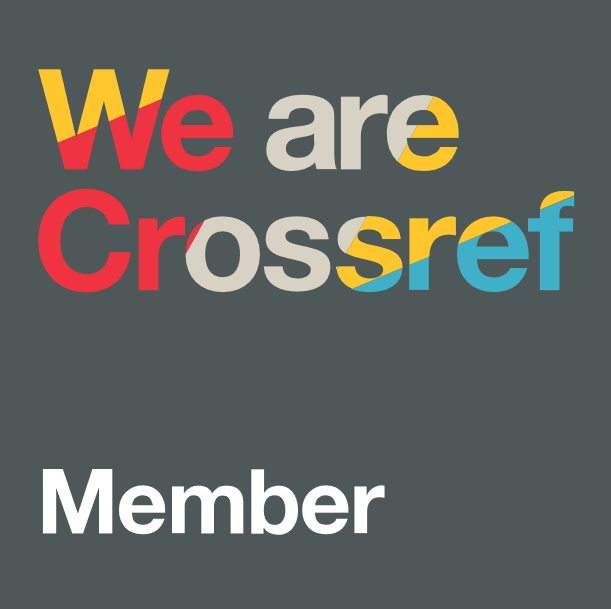Exploration of digital book learning media design for improving students' mathematical literacy abilities with the design thinking method
DOI:
https://doi.org/10.31629/jg.v10i1.7190Keywords:
mathematical literacy, android media, design thinkingAbstract
This study aims to investigate solutions to the challenges students face in learning mathematics, particularly difficulties in understanding complex material that lead to decreased motivation and low mathematical literacy during the learning process. The research employs a design thinking approach, which comprises five stages: empathize, define, ideate, prototype, and test. This study specifically focuses on the first three stages—empathizing, defining, and ideating—to identify the needs of both students and teachers and to develop appropriate solution concepts. The study population includes students from State Middle Schools (MTsN) 2 and 3 in Grobogan, with a sample size of 132 students, alongside six mathematics teachers. Data were collected via questionnaires distributed through Google Forms and supplemented by interviews. The findings reveal that both students and teachers require instructional methods supported by interactive media that are accessible online.
Downloads
References
Adawiyah, F. (2021). Variation of teacher teaching methods in overcoming student boredom in junior high schools. Paris Langkis Journal , 2 (1), 68–82. https://doi.org/10.37304/paris.v2i1.3316
Afandi & Ningsih, K. (2020). Taxonomy and model of higher order thinking learning. Untan Press, October 2020, x+186.
Aini, S. N., Munahefi, D. N., Pramasdyahsari, A. S., & Setyowati, R. D. (2024). Engineering design process stem: miniature gazebo joglo project. PRISMA, Proceedings of the National Mathematics Seminar, 7, 37–43.
Ananda, E. R., & Wandini, R. R. (2022). Analysis of teachers' perspectives in overcoming students' learning difficulties in elementary school mathematics learning. Basicedu Journal, 6 (3), 4173–4181. https://doi.org/10.31004/basicedu.v6i3.2773
Astuti, A. (2018). Implementation of realistic mathematic education (RME) improves mathematics learning outcomes of grade vi elementary school students. Jurnal Cendekia: Journal of Mathematics Education, 2 (1), 49–61. https://doi.org/10.31004/cendekia.v2i1.32
Atiyah, K., & Priatna, N. (2023). Students' mathematical literacy ability in solving PISA-based mathematics problems during the covid-19 pandemic. Jurnal Cendekia: Journal of Mathematics Education, 7 (1), 831–844. https://doi.org/10.31004/cendekia.v7i1.1648
Aulia, A., Rahmi, R., & Jufri, H. (2022). Development of android-based learning media using mip app inventor on arithmetic series and sequence material for class X SMKN 1 Kinali. Jurnal Cendekia: Journal of Mathematics Education, 6 (2), 1475–1485. https://doi.org/10.31004/cendekia.v6i2.1329
Ayu, S., Ardianti, S. D., & Wanabuliandari, S. (2021). Analysis of factors causing difficulties in learning mathematics. AKSIOMA: Journal of Mathematics Education Study Program, 10 (3), 1611. https://doi.org/10.24127/ajpm.v10i3.3824
Azhari, I. (2020). Application of design thinking in education and its challenges. Journal of Education.
Azmi, S. U., Sukestiyarno, & Rochmad. (2020). The influence of mathematical literacy skills on learning 4.0. National Postgraduate Seminar 2020, 564–569.
Benamen, R. B., Buchori, A., & Purwosetiyono, D. (2025). Analysis of learning media needs based on augmented reality using design framework . 10 (1), 13–20. https://doi.org/10.26877/b813zm44
Chastanti, I., Layyinnati, I., Srimulat, F., Fiqri, CI, Syafriyeti, R., Afriani, D. T, … & Jannah, N. (2017). Learning innovation and technology education to improve the quality of education. In Angewandte Chemie International Edition, 6(11), 951–952.
Farhana, F., Suryadi, A., & Wicaksono, D. (2021). Development of digital-based teaching materials in english subjects at SMK Atlantis Plus Depok. Instructional, 3 (1), 1. https://doi.org/10.24853/instruksional.3.1.1-17
Fatharani, W., Ariani, D., & Utomo, E. (2022). Development of gamification learning media for solar system material for grade VI elementary schools. Journal of Innovative Learning, 5 (2), 25–34. https://doi.org/10.21009/jpi.052.05
Ghayatri, A. A. (2024). Evaluation and redesign of leadership engagement support application with design thinking approach at pt pertamina hulu rokan.
Gulo, S., & Harefa, A. O. (2022). Development of interactive learning media based on powerpoint. Educativo: Journal of Education, 1 (1), 291–299. https://doi.org/10.56248/educativo.v1i1.40
Harahap, D., Silalahi, D., Hutagalung, E., Purba, M., & Tansliova, L. (2024). Analysis of teacher challenges and solutions in implementing learning strategies. Qistina: Indonesian Multidisciplinary Journal, 3 (1), 778–782. https://doi.org/10.57235/qistina.v3i1.2416
Hasanah, H. (2019). Development of printed teaching materials based on a problem-solving approach to improve mathematical literacy. GAUSS: Journal of Mathematics Education, 1 (2), 137–148.https://doi.org/10.30656/gauss.v1i2.1026
Haslinda, F., Maghfiroh, N., & Fadillah, SR (2022). Digital books as a media for literacy development. Proceedings of the National Seminar on Social Sciences (SNIIS), 576, 576–584.
Iksan, M., Farida, N., & Ferdiani, R. D. (2023). Development of smartphone-based mathematics learning media. In Jurnal sosial dan ilmu (Vol. 3, Issue 3). https://doi.org/10.59188/jurnalsosains.v3i3.716
Indrawati, Annisa, F., & Wardono. (2019). The influence of self-efficacy on mathematical literacy ability and the formation of 4c ability. Prisma, Proceedings of the National Mathematics Seminar, 2, 247–267.
Interaction Design Foundation. (2022). How might we... How might we... September, 3–4.
Juniansyah, J., Mariyam, M., & Buyung, B. (2023). Mathematical literacy ability of grade VIII students reviewed from learning independence. Jurnal Cendekia: Journal of Mathematics Education, 7 (2), 1167–1181. https://doi.org/10.31004/cendekia.v7i2.2224
Jupri, A., & Rosjanuardi, R. (2020). An Investigation of master student understanding on mathematical literacy problems. Gantang Journal , 5 (1), 1–7. https://doi.org/10.31629/jg.v5i1.1828
Kartoni, N., & Alinurdin, A. (2021). The effect of brainstorming learning model on students' self-confidence attitude in ppkn lessons. Instructional, 2 (2), 37. https://doi.org/10.24853/instruksional.2.2.37-42
Kelley, D., & Brown, T. (2018). An introduction to Design Thinking. Institute of Design at Stanford, 6.
Khadijah, U. (2023). Utilization of Augmented Reality to Improve Geometry Skills in Mathematics Learning. 3 (3), 1–13.
Kurnianto, F., Informatics, J., Industry, FT, Gustri, E., & Informatics Department, W. (2021). Application of design thinking method in ui/ux design on sekar kawung database application for sekar kawung social enterprise field employees. Automata , 3 (2), 1–69. https://dspace.uii.ac.id/handle/123456789/42600
Lutfiyana, L., Dwijayanti, I., & Pramasdyahsari, A. S. (2022). Mathematical literacy ability in solving sine and cosine rule problems reviewed from concept understanding. Jurnal Gantang , 6 (2), 151–162. https://doi.org/10.31629/jg.v6i2.3783
Manurung, M. N. U., Agung, A. A. G., & Suartama, I. K. (2024). Creative strategy of interactive learning multimedia based on game-based learning on social studies content. Journal of Media and Educational Technology, 4 (1), 51–60. https://doi.org/10.23887/jmt.v4i1.65296
Margaretta, Y., Despayani, T., Amri, Y., Watunglawar, D., & Taryana, A. (2024). Implementation of design thinking on social media content prototype of environmentally friendly air conditioning products. Scientific Journal of Management, Economics, & Accounting (MEA), 8 (2), 1904–1923. https://doi.org/10.31955/mea.v8i2.4260
Masjaya., & Wardono. (2018). The importance of mathematical literacy skills to develop mathematical connection skills in improving human resources. PRISMA, Proceedings of the National Mathematics Seminar, 1, 568–574.
Mosuka, M., Wardaningsih, F. K., Titania, G. R., Affifah, J. R., Fortuna, F., Hidayat, A., … & Melati, R. (2024). Design thinking in science learning . 4 (9). https://doi.org/10.17977/um067.v4.i9.2024.1
Muhaemin, M., & Lugis, M. M. (2023). Development of data collection instruments using design thinking stages. December, 800–813.
Mukhtar, R. U., Maimunah, M., & Yuanita, P. (2022). Development of interactive learning media development with a contextual approach to algebraic form material. Jurnal Cendekia: Jurnal Pendidikan Matematika , 6 (1), 873–886.https://doi.org/10.31004/cendekia.v6i1.1094
Mulyani, T. (2019). STEM learning approach to face the industrial revolution 4.0. National Postgraduate Seminar 2019, 7 (1), 455–460.
Muthiah, S., & Al-bahij, A. (2024). The effect of using lecture and discussion methods on elementary students' understanding of social concepts. 1256–1263.
Nuzulia, A. (1967). Media literacy. In Angewandte Chemie International Edition, 6(11), 951–952. (Issue November). https://doi.org/10.1002/anie.196709511
OECD. (2006). OECD economic outlook. In the Final report (Issue 78).
OECD. (2022). OECD economic outlook, interim report march 2022: economic and social impacts and policy implications of the war in ukraine. March, 16 pages. https://doi.org/10.1787/4181d61b-en
Pertiwi, A. D., Nurfatimah, S. A., & Hasna, S. (2022). Implementing student-centered learning methods towards the independent curriculum transition period. Tambusai Education Journal, 6 (2), 8839–8848.
Purba, O. N., Rahmah, S., Saragih, D., Sari, I. P., Suciati, R. T., Susmita, D. F., … & Maker, K. F. (2023). Implementing digital book development to improve digital literacy skills of the mass . 5 (2).
Putri, R. N., & Mahfudzah, K. I. (2024). Differentiated learning by utilizing magic school media based on artificial intelligence (AI) in Indonesian Language Learning. 2022, 1746–1754.
Razzouk, R., & Shute, V. (2012). What is design thinking and why is it important? Review of Educational Research, 82 (3), 330–348. https://doi.org/10.3102/0034654312457429
Rengga, D., & Alit, R. (2024). Analysis and Improvement of user interface (ui) to improve user experience (UX) on the Siakadu UNESA mobile application using the double diamond method. 06, 647–660. https://doi.org/10.26740/jinacs.v6n03.p647-660
Riyadi, S., Dwijayanti I., & Purwosetiyono, D. (2024). Exploration of android media design to improve students' numeracy skills with the design thinking method. JIPMat , 9 (1), 170–179.https://doi.org/10.26877/jipmat.v9i1.495
Rizkyta, A., & Astriani, L. (2024). Analysis of mathematics learning difficulties in solving story problems on flat building material for grade IV students of SDN Benda Baru 03. 593–600.
Romadhani, D., & Harahap, N. A. (2022). The effect of using website-based teaching materials on improving students' mathematical concept understanding ability. Jurnal Cendekia: Jurnal Pendidikan Matematika , 6 (2), 1222–1239.https://doi.org/10.31004/cendekia.v6i2.1340
Sagala, M., Persada, A., & Arifin, A. (2024). Application of design thinking in the development of ui / ux design for mobile pregnancy management applications. TEKNOSIA Journal , 18 (1), 30–42. https://doi.org/10.33369/teknosia.v18i1.35647
Sanjaya, P. A. (2022). Proceedings of the national seminar on history and social science education developing differentiated history learning using book creator-based e-module. PRODIKSEMA I Proceedings of the National Seminar on History and Social Science Education “Local Wisdom-Based History Learning as a Source of Character Education in the Era of Disruption,” 52–60.
Sarah, S. (2024). Analysis of technology-based learning methods in improving learning motivation of junior high school students of grade IX SMP Muhammadiyah 22 Pamulang. 1852–1860.
Satria, A. A., & Muntaha, A. (2021). 21st century educational innovation: application of design thinking and project-based learning in Indonesian education. Journal of Elementary Education, 9 (2), 1–6.
Sawitri, JI, Novita, T., Karo, B., Mutiara, C., & Barus, B. (2024). Improving the quality of learning by using interactive learning media. 1, 96–102.
Shafa, A. F., & Yunianta, T. N. H. (2022). Development of interactive learning videos assisted by geogebra applications on linear program material to improve mathematical literacy skills. AKSIOMA: Journal of Mathematics Education Study Program, 11 (2), 1127. https://doi.org/10.24127/ajpm.v11i2.4882
Siagian, M. (2017). Mathematics learning in constructivism perspective. NIZHAMIYAH: Journal of Islamic Education and Educational Technology, VII (2), 61–73.
Sitepu, E. N. (2021). Digital-based learning media. Mahesa, 1 (1), 242–248.
Sitorus, H. R., Ibrahim, A., Utama, Y., & Novianti, H. (2024). Prototype UI/UX website softcoffee with the application of the design thinking method. KLIK: Scientific Study of Informatics and Computer Design, 4 (6), 2744–2753. https://doi.org/10.30865/klik.v4i6.1881
Sugianto, A. D. P. A. R. (2017). Development of science literacy-based teaching materials on temperature and heat. Phenomenon: Journal of Mathematics and Natural Sciences Education, 7 (1), 58–67. https://doi.org/10.21580/phen.2017.7.1.1495
Sulistyawati. (2023). Qualitative research: qualitative research methods. In Jurnal EQUILIBRIUM (Vol. 5, Issue January).
Sulistyowarno, A. W., & Dwijayanti, I. (2025). Exploration of design thinking-based mathematics learning in the development of interactive media for high school students . 6 (3), 2159–2173. https://doi.org/10.38035/jmpis.v6i3.4584
Tampubolon, P., Thesalonika, Nathasya, & Rustini, T. (2022). The role of Technology-based learning media in online learning. Sultan Agung Scientific Journal, 9–21.
Taneo, P. N. L., Suyitno, H., & Wiyanto. (2015). Problem-solving ability and hard work character through the savi model with a contextual approach. Unnes Journal of Mathematics Education Research, 4 (2), 122–129.
Tobing, B. C. L., Sulistiyowati, N., & Siska, S. (2024). Redesigning the unsika e-campus design based on user experience using design thinking. Tambusi Education Journal: Faculty of Education, Pahlawan University, 8 (1), 2046– 2075.
Utomo, H. N., Muhtarom., & Dwijayanti, I. (2024). Exploration of google site interactive media. JRIP: Journal of Research and Learning Innovation, 4 (1), 42–58. https://doi.org/10.51574/jrip.v4i1.1262
Widianti, E., A. A. (2023). Literature Study: students' mathematical literacy reviewed from self-concept in the mathcitymap assisted project-based learning model. Journal.Unnes. Ac.Id, 6, 256–263. https://journal.unnes.ac.id/sju/index.php/prisma/article/view/66627
Witraguna, K. Y., Suryawan, I. P. P., No, J. U., Tegal, B., & Buleleng, K. (2026). Teachers' perceptions of high school students mathematics learning and problem-solving abilities. 08 (51).

Downloads
Published
Issue
Section
License
Copyright (c) 2025 Jurnal Gantang

This work is licensed under a Creative Commons Attribution-NonCommercial-ShareAlike 4.0 International License.

















